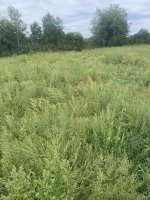cyclonenation10
Well-known member
Probably belongs in the Habitat Forum, but seems like posts get more eyeballs in the general forum.
My question is regarding strip disking. Has this practice been utilized by any on their farms or acres under their management to improve the habitat quality on existing CRP acres for pheasant/quail? I am located in eastern Iowa, and the primary birds we are managing for are pheasants, with a few partridge here and there. The majority of our acres are pretty heavily dominated by native warm season grasses, with some forbes mixed in. Probably 80/20 or so in most cases. While this serves as pretty good nesting, the brooding component is certainly lacking. We've recently put our firebreaks and such into clover/alfalfa to try and help with that, and we are burning everything on a 3 year rotation (~1/3 of the property every year). I am a big believer in burning, but I worry that it still ends up quite dense after year 1, with little ability for pheasant chicks to potentially move around and forage for bugs and such.
After seeing just how good of brooding cover our 2 year old food plots tend to produce, I can't help but think we'd be better off incorporating some strip disking into our mid contract management practices alongside burning. It seems like the best time to do so would be in the late Fall for a better forb response. What has everyone's experience been with this? Here is the pros/cons list I can think of so far..
Pros:
More bare ground/annual weeds - should lead to better poult survival/recruitment into the Fall
Increased plant diversity overall
Potentially better control of small trees invading CPR acres (compared to Spring burning) ? Would disking every 3rd year or so be enough to help tree encroachment?
Better head start in the Spring for the cover (since disking would be done in the Fall) for cover to grow up and potentially provide better nesting/brooding more quickly than a Spring burn.
Cons:
Reduced cover in the winter (not a huge concern for me, as we've got plenty of heavy winter cover, food plots, shelter belts, willow/plum thickets, etc.)
Destroying all of our native grasses - does disking to ~60% bare soil kill the native grasses/forbs or just set them back some?
Time/Money - We have the equipment, and outside of some money in fuel, time would be the only other cost. Not worried about this.
Any feedback would be much appreciated. Thinking about incorporating this practice into a small chunk of our non CRP acres (old pasture and such) to see how it does and then looking to get NRCS approval to conduct the practices on our CRP acres going forward. It seems the more and more I read up on pheasants, quail, turkey, etc., suitable brood rearing seems to be the most limiting factor in most cases - and with our dense grasses, this seems like a pretty easy and cost-effective approach.
My question is regarding strip disking. Has this practice been utilized by any on their farms or acres under their management to improve the habitat quality on existing CRP acres for pheasant/quail? I am located in eastern Iowa, and the primary birds we are managing for are pheasants, with a few partridge here and there. The majority of our acres are pretty heavily dominated by native warm season grasses, with some forbes mixed in. Probably 80/20 or so in most cases. While this serves as pretty good nesting, the brooding component is certainly lacking. We've recently put our firebreaks and such into clover/alfalfa to try and help with that, and we are burning everything on a 3 year rotation (~1/3 of the property every year). I am a big believer in burning, but I worry that it still ends up quite dense after year 1, with little ability for pheasant chicks to potentially move around and forage for bugs and such.
After seeing just how good of brooding cover our 2 year old food plots tend to produce, I can't help but think we'd be better off incorporating some strip disking into our mid contract management practices alongside burning. It seems like the best time to do so would be in the late Fall for a better forb response. What has everyone's experience been with this? Here is the pros/cons list I can think of so far..
Pros:
More bare ground/annual weeds - should lead to better poult survival/recruitment into the Fall
Increased plant diversity overall
Potentially better control of small trees invading CPR acres (compared to Spring burning) ? Would disking every 3rd year or so be enough to help tree encroachment?
Better head start in the Spring for the cover (since disking would be done in the Fall) for cover to grow up and potentially provide better nesting/brooding more quickly than a Spring burn.
Cons:
Reduced cover in the winter (not a huge concern for me, as we've got plenty of heavy winter cover, food plots, shelter belts, willow/plum thickets, etc.)
Destroying all of our native grasses - does disking to ~60% bare soil kill the native grasses/forbs or just set them back some?
Time/Money - We have the equipment, and outside of some money in fuel, time would be the only other cost. Not worried about this.
Any feedback would be much appreciated. Thinking about incorporating this practice into a small chunk of our non CRP acres (old pasture and such) to see how it does and then looking to get NRCS approval to conduct the practices on our CRP acres going forward. It seems the more and more I read up on pheasants, quail, turkey, etc., suitable brood rearing seems to be the most limiting factor in most cases - and with our dense grasses, this seems like a pretty easy and cost-effective approach.






